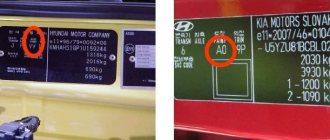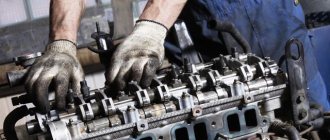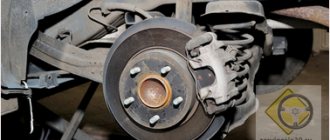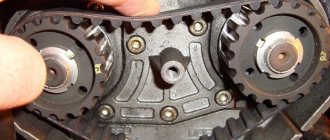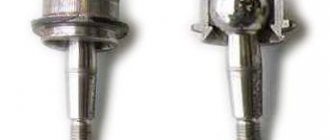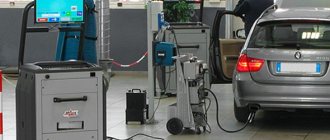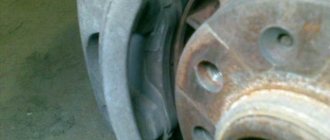What is an intercooler and what is its structure?
An intercooler is an intermediate component in the air supply system to the engine, which performs only one important function - cooling.
The part can be installed not only on gasoline, but also diesel engines. Many car enthusiasts are interested in what an intercooler is needed for. It lowers the temperature of the air, making it denser. This has a positive effect on the quality of the air-fuel mixture. Many have noticed that the engine works better at night, and all because the air is much colder. When using turbocharging, the air is heated to temperatures of 150-200 degrees Celsius. This effect adversely affects the operation of the engine as a whole, so an intercooler is used for cooling.
Visually, the part resembles a regular radiator. The component contains dozens of pipes and plates that provide effective heat transfer. The longer the pipes, the better the intercooler does its job. For better air cooling, external plates made of copper or aluminum can be welded to the intercooler. These metals have better heat transfer characteristics.
In a car, the intercooler is located between the intake manifold and the turbine compressor. You can find this component in the front of the car, slightly below the radiator (front intercooler) or above the engine. Some models can be mounted in wings. The principle of operation of an intercooler is similar to a radiator: air passes through a system of pipes and then releases heat to the environment.
Selection criteria for self-installation
Tuning your own car involves replacing or installing the intercooler yourself. If the car owner is interested in replacing the part with a more advanced model, it is worth considering the following selection criteria:
- Heat exchanger area. The size of the tubes and plates directly affects the performance of the part. There are very compact models on sale, about the size of a book. However, the feasibility of their installation is quite questionable, and is unlikely to provide an optimal increase in engine power. Before purchasing, you need to calculate the installation location of the part so that it fits exactly in the seat.
- The size of the internal section of the tubes. The design must ensure the free passage of air through it.
- Thickness of heat exchanger plates. The work is affected by the area of the part, but not the wall thickness. Chasing thick metal will only add weight to the part, but will not affect its performance in any way.
- Tube shape. The optimal choice is conical segments with the maximum possible bend radius.
- High-quality connection of pipes. This is especially important when choosing a water intercooler, since poor connection of parts will lead to coolant leakage.
Article on the topic: VAZ-2109 injector - looking for and correcting faults
Types of intercoolers
Despite the apparent simplicity of this component, the industry produces two types of products:
- Air cooling. The most common option is when heated air transfers its heat to the environment through the air.
- Water cooling. As the name suggests, the air is cooled by water. Such models are characterized by compact sizes and fairly high operating efficiency. There are a number of inconveniences, in particular, it is necessary to place not only a radiator, but also a pump with a control unit.
Also, when the liquid is heated, the efficiency of water models decreases significantly. Liquid-cooled devices are also significantly more expensive. On average, such models cost 2-2.5 times more than air models. The cheapest models are installed on cars of the domestic manufacturer AvtoVAZ. Their cost is up to 10 thousand rubles. For foreign cars, the price tags are significantly higher (from 50 thousand rubles). There are car models with such devices installed that cost several hundred thousand.
There are also custom models: ice-cooled or even liquid-cooled. They are not intended for typical consumers, but are installed exclusively on sports cars made on special projects.
Types of intercoolers
Depending on the design and operating principles, intercoolers are divided into two types:
Air
An intercooler of simple design consists of a series of tubes connected to each other by rows of plates. In fact, the purpose of the part is to pass air coming from outside through the tubes. The plates make it possible to increase the heat transfer area, and due to this, the air has time to cool before it enters the turbine.
An air intercooler allows you to reduce the temperature of the air supplied to the turbine by 40-50 degrees, which gives a 12 to 15% increase in engine power. The performance of the part can only be assessed at speeds above 30-40 km/h.
Article on the topic: How to increase engine power on “classic” VAZ models
An air intercooler, also known as an air-to-air intercooler, uses a stream of advancing air as the coolant.
Air models are installed in three places:
- Under the hood, directly above the engine.
- Behind the front bumper.
- In the side spaces of the wings.
The second and third installation options are more expedient and are more common, since they provide intense airflow. An air intercooler is most often installed on SUVs and trucks.
The disadvantages of air models are their large mass and impressive size.
Water
It uses water as a coolant, which copes with the task much more efficiently. The water intercooler is more compact and does not take up much space under the hood of the car. Although when installing it you have to find space for the pump and temperature sensor. But the efficiency of this type of part is several times higher.
On average, a water intercooler lowers the temperature by 60-70 degrees. In more advanced and expensive models, a refrigerant liquid acts as a coolant: antifreeze, antifreeze, liquid nitrogen. Due to the properties of such coolants, heat transfer doubles compared to models running on water.
Liquid absorbs heat much more intensely, which is why water-to-air intercoolers are much more efficient than their air-based counterparts
However, this type of part also has some disadvantages. The water model has a more complex design. The operation of the part is controlled by a water pump, a temperature sensor and a control unit. This leads to an increase in the cost of the structure and the complexity of repair in the event of a breakdown. Therefore, models in the lower price range mainly use air intercoolers. In addition, this device requires systematic monitoring of the coolant.
This is interesting! Domestic car models are mostly equipped with intercoolers costing about 10 thousand, while imported ones cost from 50 thousand rubles. There are more advanced models, the price of which amounts to hundreds of thousands of rubles. Sports cars manufactured on special projects are equipped with a special type of intercooler - custom, in which cooling is carried out using ice and a special liquid.
Efficiency of application
The issue of intercooler efficiency is actively discussed by motorists. This parameter is measured in degrees: how much the device was able to lower the outlet temperature relative to the air entering the intercooler. As a rule, when the temperature decreases by 10 degrees Celsius, the increase in power is about 3%. Air models lower the temperature by 40-50 degrees, which is a +12-15% increase.
Liquid-cooled intercoolers are the most effective here, as they perform a 70-degree drop, which adds a whopping 21% to power. The device also provides a slight pressure drop. An indicator of 1-2 psi is considered acceptable for a high-quality intercooler.
What is an intercooler in a car?
So, we have already briefly explained what an intercooler is for, let’s now figure out what this part is? The appearance of the intercooler, in fact, its function is not much different from a car radiator. Simply put, an intercooler is a radiator, however, it cools the air flow for the turbine.
Externally, the intercooler is the same cooling honeycomb; inside there are channels through which air passes. The intercooler is most often made of aluminum, sometimes of copper. Therefore, summing up this issue, we note for ourselves that an intercooler is a radiator that cools the air sucked in by the turbine. Got it? Go ahead!
Disadvantages of an intercooler
Despite the usefulness of this component, it has a number of significant disadvantages:
- Decreased pressure. The air flow slows down and loses energy when passing through numerous pipes.
- Weight. Even the simplest models of air radiators weigh about 20 kilograms, not to mention the need to find a place to place them. Water intercoolers are even more massive and require the installation of a pump and control unit.
- A water-cooled device requires constant monitoring of the coolant.
The intercooler is another important system in the car, which drivers will have to monitor, and in the event of a breakdown, of course, troubleshoot.
How and with what to clean the intercooler
As a rule, an attentive car owner will immediately notice that the “iron horse” has begun to behave differently. The reason for the decrease in power may just be due to accumulated pollution. How to clean the intercooler yourself and is it possible?
Many car owners clean this unit themselves, washing it only on the outside, or also clean its inside surface. In order to carry out internal cleaning, the intercooler must be dismantled by loosening the clamps and disconnecting the hoses. Then the mounting bolts are unscrewed and the device is removed. The complexity of this process depends on the specific car model and the location of the intercooler.
For external cleaning without removing the cooler, car owners use Profoam 2000 or another product that is safe for the device material and designed to remove dirt.
The intercooler should be flushed with a stream of water supplied from a hose with low pressure so as not to damage the thin aluminum elements.
However, it is worth remembering that such cleaning will not be complete and thorough.
Internal cleaning is much more effective.
After dismantling the cooler, cleaning is usually carried out in the following order:
- Small stones, insects and other debris are removed from the gaps between the plates.
- Damaged plates are corrected, growths are cleared off.
- Water under low pressure with a special detergent (Profoam 2000 or another) washes away dirt.
- Cleaning of oil inside is carried out using a special product recommended in the instructions.
If there is none, then car owners often use:
- carburetor and engine cleaning products,
- White Spirit,
- kerosene,
- petrol,
- acetone.
Flush the intercooler several times until the drained fluid remains clean. There should be gaps between the radiator fins. After cleaning, the intercooler should be dried thoroughly.
Is it possible to remove it?
From a technical point of view, the intercooler can be removed without any problems, but nothing good will come of it. Pros - you will lighten your car by several tens of kilograms and, possibly, free up space in the engine compartment. There are several disadvantages. The first is loss of power. The second is exposure to high temperatures. The engine will wear out faster, which will lead to an urgent need for repairs. Removing the intercooler from turbocharged cars is strongly discouraged.
Timely repair of the intercooler pipe is a guarantee of system reliability
In principle, if you have the proper experience, you can deal with this type of problem, such as repairing pipes, yourself, but in such cases it is much more advisable to turn to professional craftsmen. The costs of their labor will be fully paid for by your peace of mind and reliability of the subsequent operation of the system. Without the proper equipment, it is impossible to guarantee that the connections at the junction are made of truly high quality.
Our specialists have the opportunity to choose the most correct solution in accordance with the specific system and car model. After installation, we will carefully check how reliable all connections and fastenings are.
Conclusions and advice regarding the operation of intercooler pipes
A solid connecting tube that takes on the main pressure is best suited for the role of a pipe. It is desirable that the tube be made of high-strength material that does not lose its qualities under the influence of temperature changes and does not deform when in contact with oil or fuel. Today, the most popular are silicone tubes, which can easily withstand high temperatures and provide high quality connections. At the same time, other tubes may be recommended for different engine models, as professional technicians are aware of.
It is extremely important to respond as quickly as possible to the occurrence of a problem in this connection, which, despite its simplicity, plays a very important role for the entire system. Delayed repair of the intercooler pipe can ultimately even lead to failure of the turbine, which cannot withstand overinflating.
To identify the problem in a timely manner, it is recommended to inspect the connection from time to time, checking whether oil has appeared on the surface of the pipe. In addition, it is important to regularly check the serviceability of all components of the power unit system.
Our company’s specialists repair car cooling radiators, restore and repair using argon-arc welding, and repair intercoolers efficiently and quickly.
Install a new intercooler
You can tune your car by replacing the intercooler. The more pipes a model contains, the more efficiently it copes with cooling. Drivers often install more expensive and advanced models on their cars. If you are interested in such an idea, then be sure to consider a number of parameters when purchasing:
- Heat exchanger area. The large area of all tubes and plates guarantees efficient cooling. For each engine there is an optimal indicator that provides the greatest increase in efficiency.
- Internal section. Pressure losses should be minimal, so a correctly selected cross-section will allow air to pass through the system almost without problems.
- Heat exchanger thickness. Do not go for thick walls, as they do not always give the desired effect and also make the car heavier.
- Frontal area. Try to choose intercoolers with the maximum frontal area, but take into account the dimensions so that the device fits in the seat.
- Pipe shape. Experienced drivers recommend buying intercoolers whose segments are made in the form of a conical shape, and the bends have the maximum possible radius.
- Connecting pipes. Poor connections will lead to loss of pressure, and in the case of water models, you will also encounter a coolant leak.
Now you know why an intercooler is needed on a turbocharged engine, what its advantages and disadvantages are. Buying a new intercooler is one way to increase the power of a vehicle.
Intercooler cleaning and repair
Any heat exchanger is cleaned from the outside first
Intercooler repair begins with cleaning its external contaminants.
First of all, after removing the intercooler from the car, you should thoroughly clean it. This may take 2-3 hours. It is especially difficult to deal with contamination caused by drips and oil accumulations. But the result will be definitely positive:
- heat transfer will increase significantly;
- you can visually determine damage to the heat exchanger tubes.
Before attempting to solder or weld damaged areas, take care to remove any remaining oil in the intercooler. In fact, it shouldn’t be there - until the issue of the tightness of the turbocharger shaft is not properly resolved, and oil in the intercooler, alas, is a normal phenomenon (especially with very worn turbine shaft sleeve bearings). Repairing damaged intercooler tubes is very similar to repairing a radiator - choose the method of sealing cracks based on the material from which the heat exchanger tubes are made. But keep in mind that the so-called “traces of repair” do not interfere with the installation of the intercooler in its original place.

